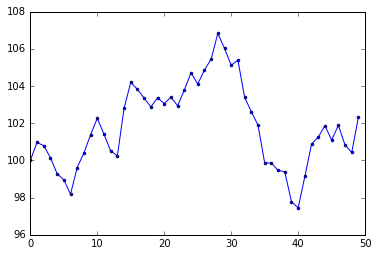Random Walk
Time Series Analysis in Python

Rob Reider
Adjunct Professor, NYU-Courant Consultant, Quantopian
What is a Random Walk?
- Today's Price = Yesterday's Price + Noise
$\large \quad \quad \ P_t \quad \ \ = \quad P_{t-1} \quad \quad \ + \ \ \epsilon_t$
- Plot of simulated data

What is a Random Walk?
- Today's Price = Yesterday's Price + Noise
$\large \quad \quad \ P_t \quad \ \ = \quad P_{t-1} \quad \quad \ + \ \ \epsilon_t$
- Change in price is white noise
$\large \quad \quad P_t - P_{t-1} \quad \ \ = \quad \ \ \epsilon_t$
- Can't forecast a random walk
- Best forecast for tomorrow's price is today's price
What is a Random Walk?
- Today's Price = Yesterday's Price + Noise
$\large \quad \quad \ P_t \quad \ \ = \quad P_{t-1} \quad \quad \ + \ \ \epsilon_t$
- Random walk with drift:
$\large \quad \quad \ P_t \quad \ \ = \ \mu \ + \ P_{t-1} \ \ + \quad \epsilon_t$
- Change in price is white noise with non-zero mean:
$\large \quad \quad P_t - P_{t-1} \ \ = \ \mu \ \ + \ \ \epsilon_t$
Statistical Test for Random Walk
- Random walk with drift
$\large \quad \quad P_t \quad \ \ = \ \mu \ \ + \ \ P_{t-1} \quad \ + \ \ \epsilon_t$
- Regression test for random walk
$\large \quad \quad P_t \quad \ \ = \ \alpha \ \ + \ \ \beta \ P_{t-1} \ \ + \ \ \epsilon_t$
- Test:
$\quad \quad \large H_0: \beta=1$ (random walk)
$\quad \quad \large H_1: \beta<1$ (not random walk)
Statistical Test for Random Walk
- Regression test for random walk
$\large \quad \quad \quad \quad P_t \quad \ \ = \ \alpha \ \ + \ \ \beta \ P_{t-1} \quad \ + \ \ \epsilon_t$
- Equivalent to
$\large \quad \quad P_t - P_{t-1} \ \ = \ \alpha \ \ + \ \ \beta \ P_{t-1} \ \ + \ \ \epsilon_t$
- Test:
$\quad \quad \large H_0: \beta=0$ (random walk)
$\quad \quad \large H_1: \beta<0$ (not random walk)
Statistical Test for Random Walk
- Regression test for random walk
$\large \quad \quad P_t - P_{t-1} \ \ = \ \alpha \ \ + \ \ \beta \ P_{t-1} \ \ + \ \ \epsilon_t$
- Test:
$\large \ \ \ \ H_0: \beta=0$ (random walk)
$\large \ \ \ \ H_1: \beta<0$ (not random walk)
- This test is called the Dickey-Fuller test
- If you add more lagged changes on the right hand side, it's the Augmented Dickey-Fuller test
ADF Test in Python
- Import module from statsmodels
from statsmodels.tsa.stattools import adfuller - Run Augmented Dickey-Test
adfuller(x)
Example: Is the S&P500 a Random Walk?
# Run Augmented Dickey-Fuller Test on SPX data
results = adfuller(df['SPX'])
# Print p-value
print(results[1])
0.782253808587
# Print full results
print(results)
(-0.91720490331127869,
0.78225380858668414,
0,
1257,
{'1%': -3.4355629707955395,
'10%': -2.567995644141416,
'5%': -2.8638420633876671},
10161.888789598503)
Let's practice!
Time Series Analysis in Python

